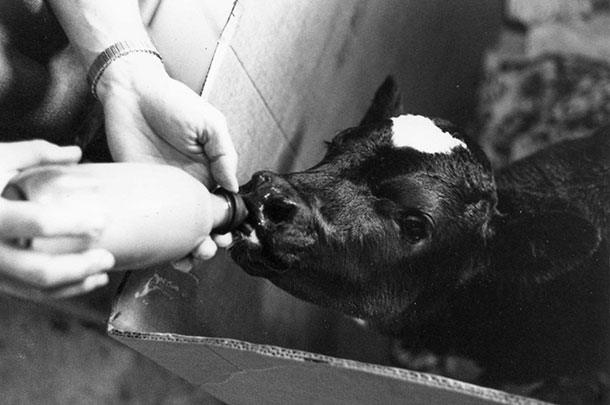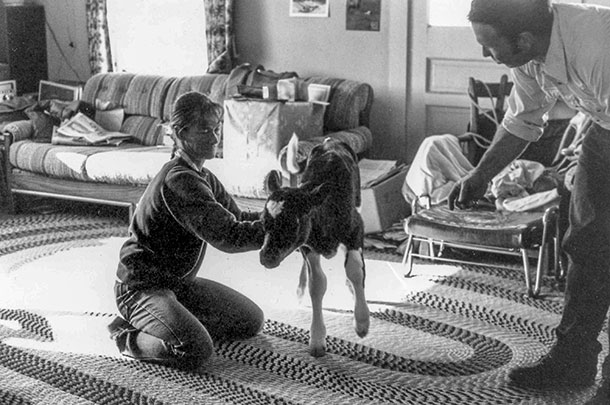Over the years, we’ve had a number of baby calves that spent time in our house – either to be thawed out after being born in cold weather or as premature babies living in the kitchen for several weeks.Some of these babies spent Christmas with us and became part of our Christmas memories.
One calf our kids named Boom Boom, and he liked to attack our Christmas tree. His story actually began earlier than Christmas because he came to our house as a very premature and fragile baby.
When our children were young teenagers, they did chores for a week in November while my husband and I went to the Oregon cattlemen’s convention. I’d been asked to speak about “Red Meat: The Original Health Food.” Baxter Black and I shared speaking honors that year; I provided the textbook stuff and he provided the humor.
At the time, we had a family milk cow who produced more milk than we could use. We sold milk to several neighbors, so the kids were delivering milk while we were gone. They took a gallon one day to Jim Bailey, who lived 2 miles up the creek. His milk cow was dry and due to calve in about six weeks.
When Michael and Andrea arrived at Jim’s place, the veterinarian was there. Jim’s cow was sick and not eating. The vet suspected hardware and was hoping to find a foreign object and remove it. But when he opened her up, he discovered she was full of infection with severe peritonitis. There was no hope of saving her.
The calf inside her was still alive, and the vet asked Jim if he wanted to save it. Jim didn’t want the calf since his cow was dying, and he didn’t have time to take care of a premature calf. Our kids offered to help take care of it, so Jim told the vet to get the calf out then gave it to the kids as a gift.
It was a bull calf, tiny and frail, at least six weeks premature. Weather was cold, so Jim loaned the kids a blanket to wrap around the calf. Andrea held him on her lap in the pickup while Michael drove home.
Andrea dried the calf with towels by our wood stove, while Michael made an “incubator” from a big cardboard box. He cut a hole near the bottom of the box so warmth from the stove would go in.
The calf was still cold and shivering, so they put a small electric heater by the hole to blow additional warm air into the box and covered the top to keep the warmth in. They also put an electric heating pad on the calf, but he still shivered for several hours.
The next urgent task was feeding him. Andrea thawed out frozen colostrum we kept for calving emergencies and tried to get the calf to nurse a bottle, but he wouldn’t suck. After a couple hours, another neighbor brought an esophageal calf feeder tube and helped the kids force-feed the little calf.
The calf was weak and listless, and the kids stayed up all night trying to get him warm. Andrea kept taking his temperature, which stayed subnormal most of the night. The colostrum gave him some strength and energy, however, and by 2 a.m., he decided he wanted to live and was hungry. When Andrea offered him a bottle of colostrum, he drank almost all of it.
A new problem emerged. By morning the calf had a fever and was breathing fast and shallow; he had pneumonia. Worried, the kids called us for advice. We were surprised to hear about their calf project and told them what to do for pneumonia. It would be a tough job to save the calf. That premature, his lungs were not yet fully developed, and pneumonia could easily kill him.
Andrea found the medications, filled the syringes and Michael gave the injections. The calf was so small and skinny, it was difficult to find enough muscle to put the antibiotic injections into. When we got home two days later and saw how tiny and frail the calf was – no bigger than a large cat – we were amazed the kids had been able to keep him alive. He was just a fragile hide stretched over tiny bones, with short, velvety hair.
The calf still had a fever, but it was starting to come down. The kids were glad for reinforcements; they were worn out after staying up nights to feed and doctor the little fellow. The calf had to be fed every four hours to keep up his energy and fluids, so he wouldn’t dehydrate from the fever.
He gradually got over the pneumonia and whenever he wasn’t sleeping, he jumped around in his box, kicked the sides or butted with his head. He was so bouncy and noisy in the box, the kids started calling him Boom Boom. He was ramming the sides so hard, we feared he might tip the box over, so we fortified it with chairs around the outside, tying them together around the box with a rope. Soon we had to add pieces of plywood to make the sides of the box higher and stronger.
After he was a few weeks old, we cut down the number of feedings (no more getting up in the middle of the night!) and gave him bigger bottles. We let him out of the box periodically for more exercise. In the living room for a few minutes of play, he bucked around chasing the kids, trying to butt heads with anyone who would play with him. It took all of us to keep him from crashing into the furniture or skidding onto the slippery dining room floor; his legs splayed out and he got stranded on his belly.
 Boom Boom was still too small and frail to go outside; temperatures dropped to 40 below zero just before Christmas. So he stayed in his box in the kitchen a bit longer. By Christmas, he’d grown to about the size he should have been at birth. He looked forward to his romps around the living room, and his antics were hilarious entertainment – as he galloped and snorted and bucked, chasing the kids or bouncing off the couch and chairs.
Boom Boom was still too small and frail to go outside; temperatures dropped to 40 below zero just before Christmas. So he stayed in his box in the kitchen a bit longer. By Christmas, he’d grown to about the size he should have been at birth. He looked forward to his romps around the living room, and his antics were hilarious entertainment – as he galloped and snorted and bucked, chasing the kids or bouncing off the couch and chairs.
Soon after Christmas, we fixed Boom Boom a stall in the barn with fluffed-up hay for bedding so he could snuggle into it and keep warm. He liked the barn stall; there was more room to run and buck.

The kids were sad to see him go outside. They thought it was fun having him in the house, even though the box in the kitchen was an awkward obstacle, and we had to keep washing the towels used for bedding. The big box took up most of our small kitchen area, making it difficult to get to some of the cupboards. It was also hazardous to spend much time by the stove, since Boom Boom would try to chew on anyone he could reach. I’d be stirring something on the stove and suddenly feel my shirt being pulled by his inquisitive mouth.
We fed him milk from our old Holstein cow until Liza calved in January. Liza was a crossbred daughter of our 18-year-old Holstein and usually raised three or four calves. If we had an orphan or a heifer that didn’t want to be a mother, Liza raised those calves. She gave birth to a big bull calf in late January, and we gave her another baby. Boom Boom was happy to have a real mother and a brother. Now he had someone to rough-house with besides us.
We were proud of the kids for saving him in those precarious days when his condition was critical, and we weren’t there to help. They earned him. He became a big yearling and a pet, and the kids were reluctant to sell him, even though they planned to convert him into savings for college.
Raising him was a good experience, nursing him into the world and saving his life. It was a challenge that gave them much satisfaction and sense of accomplishment, and he will always have a place in our memories as one of our favorite “Christmas calves.” ![]()
PHOTO 1: The author Heather Thomas bottle feeds Boom Boom.
PHOTO 2: The cardboard box pen made for some temporary housing, with some romps in the house for exercise in the winter.
PHOTO 3: Before long, Boom Boom grew sufficiently to outgrow the box – and the living room. Photos provided by Heather Smith Thomas.
Heather Thomas is a freelance writer based in Idaho.









